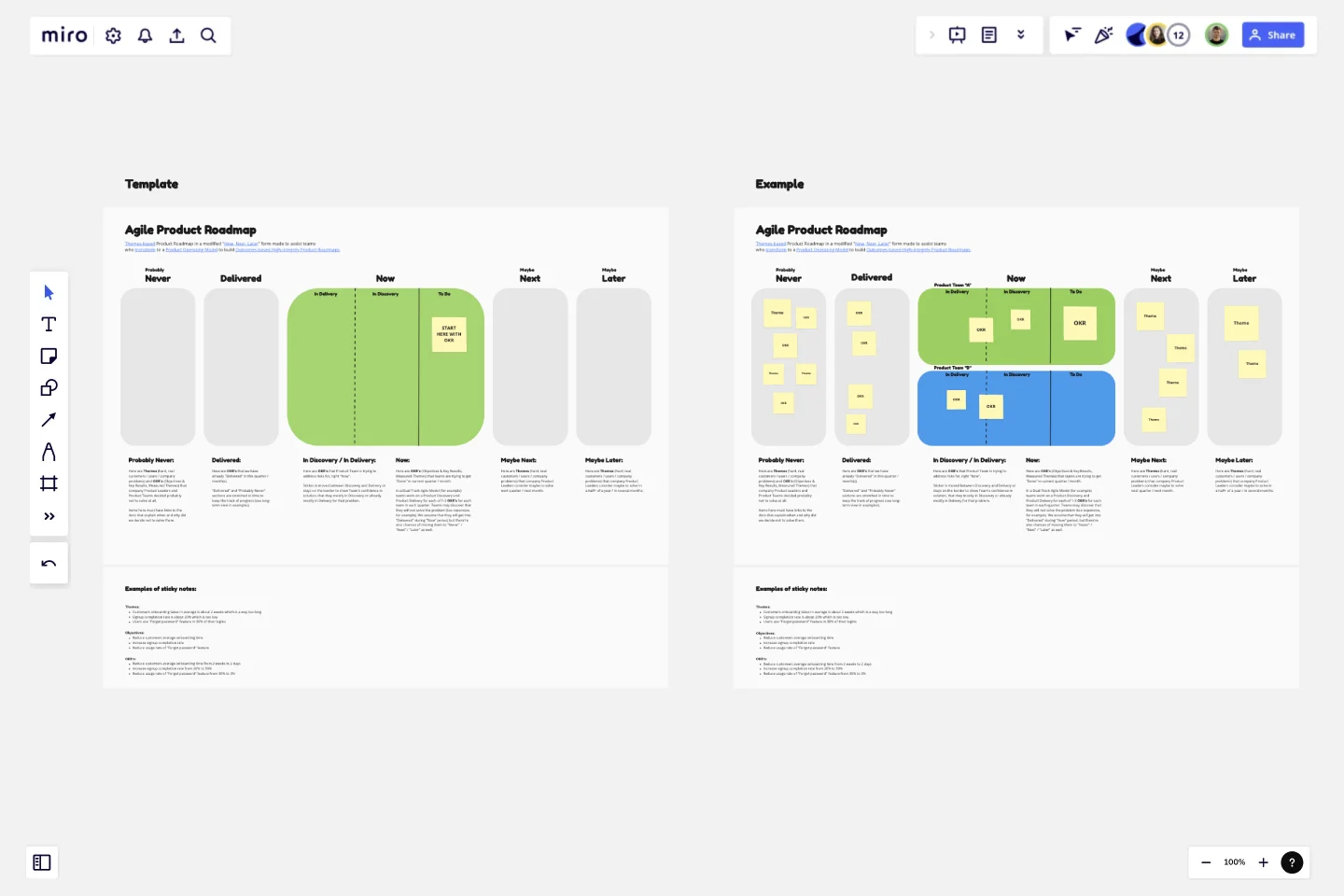Agile Product Roadmap (Now, Next, Later)
This is a Themes-based Product Roadmap in a modified "Now, Next, Later" form made to assist teams who transform to a Product Operating Model to build Outcomes-based High integrity Product Roadmaps because it is so different from what those teams are used to see and use as Product Roadmaps.
This Roadmap has prefixes "probably", "maybe" in addition to "Never", "Next", "Later" to emphasize its agility nature: if something is on Agile Roadmap it doesn't mean that it will be eventually delivered to the customers. It's absolutely not!
How to use Agile Product Roadmap
Start with the "Now" section. Add some Themes (hard, real customers/users/company problems that your team is working this quarter/month) sticky notes to a "To Do" section of "Now." Themes must be based on (i.e., exist there because of, prioritized, and split among the existing teams) a Product Strategy created by Product Leaders. "Now, Next, Later" sections represent Product Strategy prioritization. The "Now" section split by Product Teams represents teams topology. Example of Theme: "Signup completion rate is about 20%, which is too low."
Move some of Themes from "Now" to "Next" and "Later" sections to init Product Roadmap prioritization (or simply create new Themes in those sections).
Change Themes in a "To Do" list of "Now" section to OKR's (Objectives & Key Results). Example of OKR: "Increase signup completion rate from 20% to 50%."
Move sticky notes from "To Do" to "Discovery / Delivery" and then to "Delivered" or to "Next" or to "Later" or even to "Never". Working in a Product Operating Model, we do Product Discovery and Product Delivery. It may happen that the team discovers that it is very expensive for a company to solve this problem. And that's why this problem (an OKR) will get to "Never" instead of "Delivered."
Use "Delivered" section to keep sticky notes there when you start a new quarter/month - so you can see what you've recently done. This helps to change and track the course of the Product Strategy.
Keep items in the "Never" section. Once a sticky note gets to a "Never" section we need some document that explains the story behind that sticky note: what was Discovered that lead to a conclusion that our company Product Leaders (along with the Product Teams) decided not to deliver a solution to that problem (at least for now).
This template was created by Aleksei Soskov.
Get started with this template right now.
Idea Funnel Backlog
Works best for:
Design, Brainstorming, Agile Workflows
An Idea Funnel Backlog enables you to visualize your backlog and restrict the number of backlogged items at the top. In doing sos, you can prioritize items on your list without having to engage in unnecessary meetings or create too much operational overhead. To use the Idea Funnel Backlog, break up the funnel into different phases or treat it like a roadmap. Use the Idea Funnel Backlog as a hybrid model that combines your roadmap and backlog into one easily digestible format.
Project Charter Template
Works best for:
Project Management, Documentation, Strategic Planning
Project managers rely on project charters as a source of truth for the details of a project. Project charters explain the core objectives, scope, team members and more involved in a project. For an organized project management, charters can be useful to align everyone around a shared understanding of the objectives, strategies and deliverables for a project of any scope. This template ensures that you document all aspects of a project so all stakeholders are informed and on the same page. Always know where your project is going, its purpose, and its scope.
Retrospective
Works best for:
Retrospective, Agile Methodology, Meetings
The Retrospective template offers a versatile and adaptable framework for teams to reflect on their performance and processes. It provides elements for sharing feedback, identifying lessons learned, and brainstorming improvements. This template enables teams to foster open communication, identify opportunities for growth, and enhance collaboration. By promoting reflection and transparency, the Retrospective empowers teams to continuously learn and evolve, driving greater efficiency and effectiveness in their work.
Product Backlog Template
Works best for:
Agile Methodology, Kanban Boards, Product Management
Development teams are often juggling many products at once. A product backlog is a project management tool that helps teams keep track of projects in flight as they build and iterate, so you can store everyone's ideas, plan epics, and prioritize tasks. The highest-priority tasks are at the top of the product backlog, so your team knows what to work on first. Product backlogs make it easier for teams to plan and allocate resources, but it also provides a single source of truth for everyone to know what development teams are working on.
Product Strategy Workshop
Works best for:
Product Management, Planning
The Product Strategy Workshop template facilitates collaborative sessions for defining and refining product strategies. By providing frameworks for analyzing market dynamics, identifying customer needs, and setting strategic goals, this template fosters alignment among cross-functional teams. With sections for SWOT analysis, value proposition development, and goal setting, it enables teams to create comprehensive product strategies that drive business growth and customer satisfaction.
The Lightning Product Audit
Works best for:
Product Management, Planning
The Lightning Product Audit template streamlines product evaluation processes with a comprehensive framework. By assessing key areas such as market fit, user experience, and feature performance, this template enables teams to identify strengths, weaknesses, and areas for improvement swiftly. With sections for conducting SWOT analysis, user feedback review, and competitive benchmarking, it facilitates data-driven decision-making and prioritization. This template serves as a catalyst for refining product strategies and driving continuous improvement.
